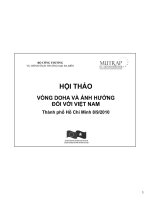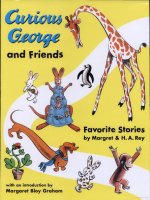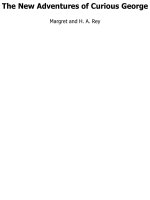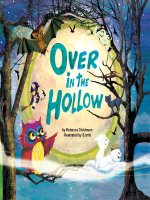H a rey margret rey CURIOUS GEORGE 01 curious george and friends (v5 0)
Bạn đang xem bản rút gọn của tài liệu. Xem và tải ngay bản đầy đủ của tài liệu tại đây (27.55 MB, 425 trang )
Curious George and Friends
Margret and H. A. Rey
With an introduction by Margaret Bloy Graham
Curious George and Friends
Favorite Stories
by Margret & H. A. Rey
Houghton Mifflin Company Boston 2003
With appreciation to Lay Lee Ong,
Emily West, and Norman West
All rights reserved. For information about permission to reproduce selections from this
book, write to
Permissions, Houghton Mifflin Company, 215 Park Avenue South, New York, New York
10003.
www.houghtonmifflinbooks.com
Curious George
Copyright © 1941 and © renewed 1969 by Margret E. Rey. Copyright assigned to
Houghton Mifflin Company in 1993
Cecily G. and the 9 Monkeys
Copyright © 1942 by H. A. Rey. Copyright © renewed 1969 by H. A. Rey
Elizabite: Adventures of a Carnivorous Plant
Copyright © 1942 by H. A. Rey. Copyright © renewed 1969 by H. A. Rey
Pretzel
Copyright © 1944 by H. A. Rey. Copyright © renewed 1972 by Margret Rey
Katy No-Pocket
Copyright © 1944 by Houghton Mifflin Company. Copyright © renewed 1972 by Emmy
Govan West
Spotty
Copyright © 1945 by H. A. Rey. Copyright © renewed 1973 by Margret Rey
Billy's Picture
Copyright © 1948 by Margret and H. A. Rey. Copyright © renewed 1976 by Margret and
H. A. Rey
Whiteblack the Penguin Sees the World
Copyright © 2000 by Lay Lee Ong
Introduction copyright © 2003 by Margaret Graham Holmes
Illustrations in introduction from: Curious George Rides a Bike; the Rey estate, provided
by the de Grummond Children's
Literature Collection, the University of Southern Mississippi, Hattiesburg; and Curious
George Gets a Medal.
ISBN
0-618-22610-9
Manufactured in the United States of America
DOW 10 9 8 7 6 5 4 3 2 1
Contents
Introduction by Margaret Bloy Graham [>]
Curious George [>]
Cecily G. and the 9 Monkeys [>]
Elizabite [>]
Pretzel [>]
Katy No-Pocket written by Emmy Payne [>]
Spotty [>]
Billy's Picture [>]
Whiteblack the Penguin Sees the World [>]
A Few Notes about Curious George and Friends [>]
Memories of the Reys
By lucky chance Hans Rey's niece was in New York City when I first arrived in May 1943.
A mutual friend had asked her to look me up. I had just graduated from the University of
Toronto in art history and had a student visa to attend summer classes at the Art
Students League. I hoped to stay on in New York and illustrate children's books. So when
Lottie said she would introduce me to her aunt and uncle, Margret and Hans Rey, who
were in that field, I was delighted.
Although I had never heard of the Reys, I soon discovered that they were well
known. They had come from Germany via France and Brazil in 1940 and already had had
several books published in the United States, as well as in France and England.
The Reys lived in Greenwich Village, as I did, and life there was casual and fun.
Washington Square, where they lived, was a great meeting place, and the Reys knew lots
of people—friends and authors and artists from all over. Margret was the more
gregarious; Hans was quieter, with a smile for everyone. Most of the people they knew
had dogs and walked them every evening in the square. Margret and Hans had a black
cocker spaniel, Charkie, the first of a succession of spaniels. When Charkie got old and his
whiskers turned white, people would say, "Poor old dog." Margret soon stopped such
remarks by dyeing his whiskers black. The Reys' dogs were an important part of their life,
and Hans sometimes put Margret and Charkie in his illustrations, as in The Park Book and
Curious George Rides a Bike.
I had no experience in book illustration, and no samples or portfolio. When I asked
the Reys for advice, Hans, who was always kind and helpful, encouraged me to make
some samples. This was fortunate, because one day in 1948 Margret called and said that
Ursula Nordstrom at Harper, one of the best children's book editors in the business, had
asked if she knew any new artists for a new book, and Margret recommended me. So I
began my career with Harper.
The Reys had a charming, light, and airy third-floor studio apartment overlooking the
trees in Washington Square. Whenever I visited them
I would see books being created: sketches, pieces of type, and dummies spread all over.
Generally the books began with one of Hans's great pictorial ideas, such as the soap
powder episode in Curious George Gets a Medal.
Hans's drawings have a wonderful vitality, a feeling of life and motion and fun. When
the Boston Public Library had a big exhibit of the Reys' work in 2000, I was thrilled to see
a very early drawing, done when Hans was eight, of people riding in a park in Hamburg.
The horses move and prance, and one realizes how obvious his talent was from the
beginning.
Margret was a gifted idea person, writer, and editor; she was very like Curious
George, mischievous and inquisitive. Hans and Margret were a perfect picture-book team.
Together they constructed the story amid lots of arguments and changes. Sometimes
Margret would quickly take a sketch from Hans, cut it up, and put it together in a more
dramatic way. Margret could be very critical, as all who met her soon found out. Both
Reys were meticulous craftsmen: each page was carefully designed and every detail
thoroughly worked out. Hans did four-color separations of the artwork: each color had to
be interpreted in black and gray on a separate sheet of paper, a difficult and demanding
task.
In 1963 Margret and Hans moved to Cambridge, Massachusetts, and spent summers
in Waterville Valley, New Hampshire. Living close to Harvard Square, the Reys lived very
much as they had in New York. Cambridge in the 1960s was similar to the Village in the
1940s and '50s. There were get-togethers with friends and relatives, dog walking,
socializing in the street, visits to bookshops and art galleries, concerts and parties. The
Reys always gave a New Year's Eve party with champagne and beautiful hors d'oeuvres
lovingly made by Hans. In Cambridge they had a large house and a small garden; in
Waterville Valley, a small house and a large garden. Margret was an avid and
enthusiastic gardener; she was always busy and cheerful, singing as she dug and planted.
She was also an enthusiastic potter, taking lessons at the Cambridge Center for Adult
Education and the Haystack Mountain School of Crafts in Maine.
Hans's passion was astronomy; he wrote two very successful books: The Stars: A
New Way to See Them and Find the Constellations, a star book for children. He had
clever new ideas and made excellent, easy-to-read star charts. He always had a
telescope at hand and loved showing
people the stars. In Cambridge he would set up his telescope in front of the house and
invite the neighbors to take a look. He always had a cluster of fascinated people around
him. It was the same in Waterville Valley, where the clear night skies delighted him.
When I moved to Cambridge in the summer of 1965, I was working on the first book
that I both wrote and illustrated, Be Nice to Spiders, about a spider named Helen. Before
the Reys went to Waterville for the summer, I showed the dummy to Margret and asked
for her advice. She sent me the following:
Re: Helen: I think you are doing alright. You just have to learn how
to put a story together. A story should always have a hero (Helen)
whom you can identify with, or let's say, feel with. And it should
come to a climax, the climax in your case being that Helen nearly
gets killed when they clean up. Maybe it needs a scene, picture,
when they clean up and nearly get her with the broom. And then
an ending, in this case the discovery that Helen is doing good, plus
an end picture which should come quickly, not an ending that is
drawn out too long. Well—that's the way I see it, but I guess I said
that all before.
I came to know the Reys much better after I moved to Cambridge. They were a great and
lasting influence on my life, and I am eternally grateful to them both.
—MARGARET BLOY GRAHAM
Cambridge, Massachusetts
July 2002
Curious George
by
H. A. Rey
This is George.
He lived in Africa.
He was a good little monkey
and always very curious.
One day George saw a man.
He had on a large yellow straw hat.
The man saw George too.
"What a nice little monkey," he thought.
"I would like to take him home with me."
He put his hat on the ground
and, of course, George was curious.
He came down from the tree
to look at the large yellow hat.
The hat had been on the man's head.
George thought it would be nice
to have it on his own head.
He picked it up and put it on.
The hat covered George's head.
He couldn't see.
The man picked him up quickly
and popped him into a bag.
George was caught.
The man with the big yellow hat
put George into a little boat,
and a sailor rowed them both
across the water to a big ship.
George was sad, but he was still
a little curious.









